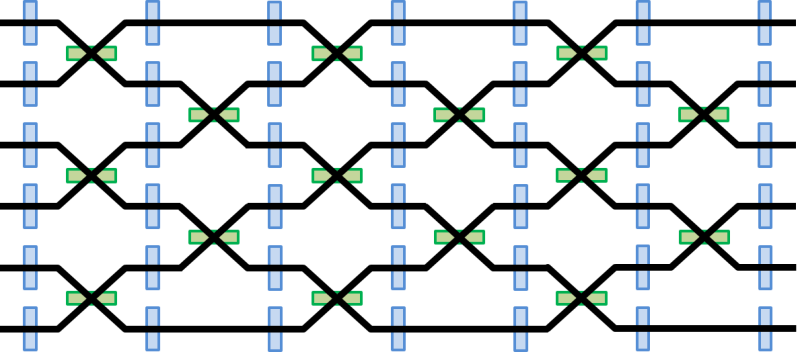'Virtual' interferometers may overcome scale issues for optical quantum computers

It's not the size of the interferometer that matters; it's how you use it. So claim a team of researchers from RMIT University, the University of Sydney and University of Technology Sydney, who have devised an entirely new way of implementing large-scale interferometers that will dramatically miniaturise optical processing circuitry.
The team, in a paper published in Physical Review Letters, has shown that a small-scale physical interferometer can do the work of a much larger one by leveraging recent breakthrough results in quantum information. The technique has been dubbed 'measurement-based linear optics'.
"A clear advantage of our approach is that it harnesses existing compact methods for generating large-scale cluster states - a resource for quantum computing," says lead author Dr Nicolas Menicucci.
"Six beamsplitters and a few squeezed light sources give us the potential to access virtual optical networks of an immense size."
According to first author Dr Rafael Alexander, engineering conventional interferometers that comprise hundreds or even thousands of optical elements is a daunting but important task that is essential to implementing fully-functional optical quantum computers.
"We found a new approach to dealing with this problem by drawing inspiration from quantum teleportation," says Dr Alexander.
"Measurement-based linear optics circumvents many of the challenges facing the conventional optics approach by using large virtual interferometers instead of physical ones. By applying of a specific sequence of measurements to a continuous-variable cluster state, the measurements themselves program and implement the interferometer," he said.
"We use a gigantic cluster state composed of modes of light correlated in time or frequency, which can be generated using just one or two optical parametric oscillators (which implement optical squeezing) and just a handful of beamsplitters."
The team's experimental collaborators have already demonstrated the technology, yielding cluster states composed of more than 1 million entangled modes.
"Measurement-based linear optics has the potential to reshape how we think about the interference of light," says Dr Menicucci.
"It ports the demonstrated scalability of continuous-variable cluster states to the broad range of linear-optics applications."
The paper also details a technique to overcome the usual noise (distortion) faced by any 'virtual' approach like this one by converting this noise into simple photon loss, which is easier to handle. This opens the door to new approaches for combatting noise - a major challenge facing all large-scale quantum computing platforms.
More information: Rafael N. Alexander et al, Measurement-Based Linear Optics, Physical Review Letters (2017). DOI: 10.1103/PhysRevLett.118.110503
Journal information: Physical Review Letters
Provided by Centre for Quantum Computation & Communication Technology



















